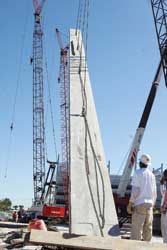South Florida Tilt-Up Concrete Panel Is A Record at 96.6 Ft
 |
| Options. Tilt-up was used to save space, time and money. (Photo courtesy of Seminole Hard Rock Hotel & Casino) |
A Florida contractor has staked claim to a tilt-up concrete world record by forming and placing a 96.6-ft tall wall panel at a new parking garage. The panel is part of a 2,300-space, seven-story parking structure being built for a tribal hotel and casino.
“It’s official, this is a world record holder,” says James R. Baty II, technical director for the Tilt-Up Concrete Association, Mount Vernon, Iowa. “The previous two record holders achieved their height by extending only a portion of their panels, whereas this panel is a fully extended rectangular panel.”
Baty says the previous record was the end wall to the nave of the Seven Rivers Presbyterian Church, Lecanto, Fla., at 92 ft 10 3/4 in. But the top 10-ft was a concrete cross monolithic to the panel. “We have always talked about a 100-ft [technical barrier] and this new panel shows that it is within striking distance,” says Baty. “Eventually, that too will fall, like so many other tilt-up myths.”
Baty notes that tilt-up panels typically weigh about 150 lb per cu ft. The record-setting panel only weighed about 30 tons, nowhere near the 156-ton weight-record holder.
Tiltcrete LLC, Medley, Fla., hoisted the 6-ft wide stair tower panel into place on Feb. 6 as part of the new 800,000-sq-ft steel-framed Lucky Street Parking Garage, scheduled to open in mid-2006. The panel was formed onsite and lifted into place bya 150-ft lattice-boom crane with jib using 75-ft to 100-ft slings.
The structure uses 78 stairwell and elevator shaft panels and 18 types of spandrel panels. The rest of the parking garage is cast-in-place concrete.
“Tilt-up was used because it is easier in a very tight site,” says project architect Marvin Scharf, Scharf & Associates, Ft. Lauderdale. “We can cast panels on the ground on top of each other rather than form them vertically. It is more expedient and less costly.”
The 6-ft-wide record-breaking panel required some special engineering. “It was a collaboration between Tiltcrete and [engineer] Dave Kelly that required a thicker modification from 91⁄4 in. to 111⁄4 in. in order to overcome deflection,” says Scott L. Collins, engineering manager, Meadow Burke Products, Sacramento, Calif., the lifting engineer. “It was a straight-forward tilt-up, but we just made it thick and tall with double mat reinforcing 6 in. on center.” Kelly is Meadow Burke’s chief engineer.
“This was the tallest piece, but there were some 70-footers that were 12-ft to 18-ft wide, which is also pushing the envelope,” says Kelly. “The most critical part of the project was how to brace it once it was vertical. Normally, you need to brace at about 60% of height and, if using pipe braces, we would have needed about 80-ft braces attached to the ground 40-ft from the structure, which would have complicated things.”
Kelly says the firm bypassed that problem by attaching the panel to the structure rather than to the ground. “We used two temporary points so the crane could be released, and finally connected [the panel] with many permanent welds,” he explains.
The $20-million garage is part of the tribal-owned Seminole Hard Rock Hotel & Casino, Hollywood, Fla., which opened in 2004 and already has drawn more than 5 million visitors. The existing 6,000 surface parking and 1,800 garage spaces were not enough, says Julianne Carelli, Seminole spokeswoman. “We have a large casino plus 481-bed hotel and 24 retail outlets, 17 restaurants and 11 nightclubs,” she notes.
